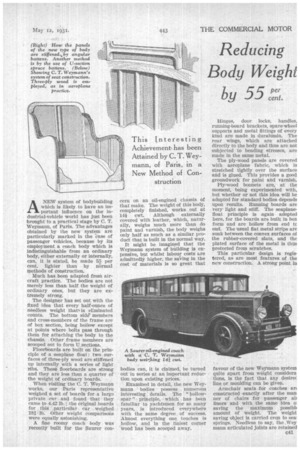Reducing Body Weight by 55
Page 111

If you've noticed an error in this article please click here to report it so we can fix it.
This Interesting Achievement, has been Attained by C. T. Weyinann, of Paris, in a New Method of Con
struction
ANEW system of bodybuilding which is likely to have an important influence on the industrial-vehicie world has just been brought to a practical stage by C. T. Weytnann, of Paris. The advantages obtained by the new system are particularly marked in the Case of passenger vehicles, because by its employment a coach body which is indistinguishable from an ordinary body, either externally or internally, can, it is stated, be made 55 per cent. lighter than by normal methods of construction.
Much has been adapted froth aircraft practice. The bodies are not merely less than half the weight of ordinary ones, but they are extremely strong.
The designer has set out with the fixed idea that every half-ounce of needless weight that,. is eliminated counts. The bottom side members and cross-members of the frame are of box section, being hollow except at points where bolts pass through them for attaching the body to the chassis. Other frame members are scooped out to form TJ sections.
Floorboards are built on the principle of a seaplane float : two surfaces of three-ply wood are stiffened up internally with a series of light ribs. These floorboards are strong and they are less than a quarter of the weight of ordinary boards.
When visiting the C. T. Weymann works, our Paris representative weighed a set of boards for a large private .car and found that they came to 4.42 lb.; the original boards for this !;particular ear weighed 181 lb. Other weight comparisons were equally astonishing.
A fine roomy coach body was recently built for the Saurer con
cern on an oil-engined chassis of that make. The weight of this body, completely finished, works out at 14i cwt. Although externally covered with leather, which, naturally, weighs much more than do paint and varnish, the body weighs only half as much as a similar product that is built in the normal way.
It might be imagined that the Weyinann system of building is expensive, but whilst labour costs are admittedly higher, the sdiring in the cost of materials is so great that bodies can, it is claimed, be turned out In serieS at an important reduction upon existing prices.
Examined in detail, the new Weymann bodies possess numerous interesting : details. The " hollowspar " principle, which has been familiar to yachtsmen for so many years, is introduced everywhere with the same degree of success. Almost everything one touches is hollow, and in the tiniest corner , Wood ha S been scooped away. Hinges, door locks, handles, running-board brackets, spare-wheel supports and metal fittings of every kind are made in duralumin. The rear wings, which are attached directly to the body and thus are not subjected to bending stresses, are made in the same metal.
The ply-wood panels are covered with aeroplane fabric, which is stretched tightly over the surface and is glued. This provides a good groundwork for paint arid varnish.
PIy-wood bonnets are, at the moment, being experimented with, but whether or not this idea will be adepted for standard bodies depends upon results. Running boards are very light and stiff. The seaplanefloat principle is again adopted here, for the boards are built in box form and are hollow from end to end. The usual flat metal strips are sunk between the convex surfaces of the rubber-covered slats, and the plated surface of the metal is thus protected from scratches.
This particular design is registered, as are most features of the new construction. A strong point in favour of the new WeYmann system quite apart from weight considera tions, is the fact that any desired line or moulding can be given. Armchair seats for coaches ar( constructed exactly after the man ner of chairs fOr pasSenger aui liners and with the same idea 01 saving the maximum Peissibh amOunt of weight. The weight saving object is carried even to seal springs. Needless to say, the ,Wey mann articulated joints are retained




































































































































































































